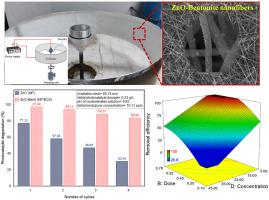Journal of Cleaner Production ( IF 9.7 ) Pub Date : 2023-05-30 , DOI: 10.1016/j.jclepro.2023.137652 Alireza Amini , Farhad Rahmani , Mehrdad Kkamforoush , Rojiar Akbari Sene

|
Herein, photocatalytic features and performance of ZnO nanofiber mats spun by electro and electro-centrifuge spinning methods were evaluated by various characterization techniques and the UV-degradation of bentazon herbicide, respectively and then, compared with those of ZnO nanoparticles. Because of higher productivity and more flexibility in loading nanoparticles, the electro-centrifuge spinning method was chosen to fabricate bentonite nanoparticles incorporated ZnO nanofiber mats. The FESEM images clearly indicate the formation of 0D/1D nanoparticle/nanofiber morphologies in samples. XRD, EDX and FTIR analyses confirmed the formation of ZnO and the existence of bentonite. Based on the PL analysis, the bentonite nanoparticles get to inhibit the charge recombination. However, its excessive incorporation causes intense loss of active sites numbers and the surface coverage of ZnO nanofibers which restrict the light absorption as evidenced by FESEM and UV-DRS results. After 2h irradiation, the efficiency removal of bentazon reached from 85.23% by pure ZnO nanofibers to 100% by composite nanofiber mats containing 5 wt.% bentonite (ZnO-Ben5 (NF-ECS)). Nonetheless, the removal efficiency declines upon further increasing the content of incorporated bentonite. The kinetics study disclosed that the photocatalytic bentazon removal was best fitted with the first order model (R2 = 0.9907) with the maximum rate constant of 0.0243 min−1 over ZnO-Ben5 (NF-ECS). Moreover, RSM-CCD analysis was employed to model and optimize the photocatalytic treatment process. A reduced cubic model (Adj. R2 = 0.9934, p˂0.0001) was proposed for interpreting the system behavior. Under optimal operating conditions (photocatalyst dosage of 0.33 g.L−1, initial solution pH of 8.92, bentazon concentration of 10.11 ppm and irradiation time of 85.78 min), ZnO-Ben5 (NF-ECS) eliminated approximately 83% of bentazon after four-time recycling, reflecting a sustained great activity.
中文翻译:

膨润土纳米颗粒掺入 ZnO 纳米纤维毡通过电离心纺丝组装,用于苯达松除草剂的高效光降解:调整组成和工艺优化
在此,通过各种表征技术和苯达松除草剂的紫外线降解分别评估了通过电纺和电离心纺丝方法纺成的 ZnO 纳米纤维垫的光催化特性和性能,然后与 ZnO 纳米颗粒进行了比较。由于更高的生产率和装载纳米粒子的更大灵活性,选择电离心纺丝方法来制造膨润土纳米颗粒掺入 ZnO 纳米纤维垫。FESEM 图像清楚地表明样品中 0D/1D 纳米颗粒/纳米纤维形态的形成。XRD、EDX 和 FTIR 分析证实了 ZnO 的形成和膨润土的存在。基于 PL 分析,膨润土纳米颗粒开始抑制电荷复合。然而,其过量掺入会导致活性位点数量的大量损失和 ZnO 纳米纤维的表面覆盖,从而限制光吸收FESEM 和 UV-DRS 结果证明了这一点。辐照 2 小时后,苯达松的去除效率从纯 ZnO 纳米纤维的 85.23% 到含有 5 wt.% 膨润土的复合纳米纤维垫 (ZnO-Ben5 (NF-ECS)) 的 100%。尽管如此,随着进一步增加掺入膨润土的含量,去除效率会下降。动力学研究表明,光催化苯达松去除最适合一阶模型 (R 2 = 0.9907) ,ZnO-Ben5 (NF-ECS) 的 最大速率常数为 0.0243 min -1 。此外,RSM-CCD 分析用于模拟和优化光催化处理过程。简化的立方模型(Adj. R 2 = 0.9934, p˂0.0001) 被提议用于解释系统行为。在最佳操作条件下(光催化剂剂量为 0.33 gL -1,初始溶液 pH 值为 8.92,苯达松浓度为 10.11 ppm,照射时间为 85.78 分钟),ZnO-Ben5 (NF-ECS) 在四次后消除了大约 83% 的苯达松循环利用,体现了一项持续性的伟大活动。











































 京公网安备 11010802027423号
京公网安备 11010802027423号